CE11002 | Concept of Structural Member and Structural Behaviour
Added on 2020-03-04
22 Pages9906 Words432 Views
1) STRUCTURAL MEMBER & STRUCTURAL BEHAVIOURAny building or structure is made up of different components or elements like Plates,columns, bracing, support, sill, beam, catenaries, shells, etc. These elements are often referredto as structural members. These members could be divided into different categories as givenbelow.a.Dead and Live Load-Bearing Members – These members distribute the load on thestructure equally. The sum of dead load (total weight of the structure) and live load(total weight of movable objects) is equal to total load supported by the structuralmembers. The entire dead load is supported by the ground or earth whereas, the liveload is supported by horizontal members like columns and beams (Heyman, 1999).b.Vertical Structural Members – The horizontal members carrying the live load rests onvertical structural members like pillars, piers and studs (Heyman, 1999).c.Horizontal Structural Members – These horizontal members are used to support roof,trusses, ends of floor beams, wall ends of rafters, etc. Examples of such members arerafters, purlins, plates, etc. (Heyman, 1999).The most important and simplest principle to understand the structural behavior ofdifferent members is the principle of equilibrium. A building is safe if its structural parts arestable and stationary which is achieved only when equal and opposite forces are acting onthem (Blank et al., 1993). When this is achieved the building is said to be in equilibrium. Thebehavior of structures under different types of strains are discussed in the succeeding section.a.Behavior of Structural Members under Tension – Tension is the force acting on amaterial when it is tightly held between a movable and an immovable jaw withthe movable jaw being loaded with weight. The material elongates under the loadand if the load is increased beyond a certain limit the elongation would increasewithout applying any load, this point is called yield point. Loading beyond thisyield point results in fracturing the material (Hosford, 2005)b. Behavior of Structural Members under Compression - When structural membersare applied with pressure, the member is subjected to compressive force and itleads to a failure called transverse splitting (Hosford, 2005).c.Behavior of Structural Members under Bending – Consider a structural memberbeing affected by both tensile and compressive forces, the member would have abending moment which bends the member (Hosford, 2005).
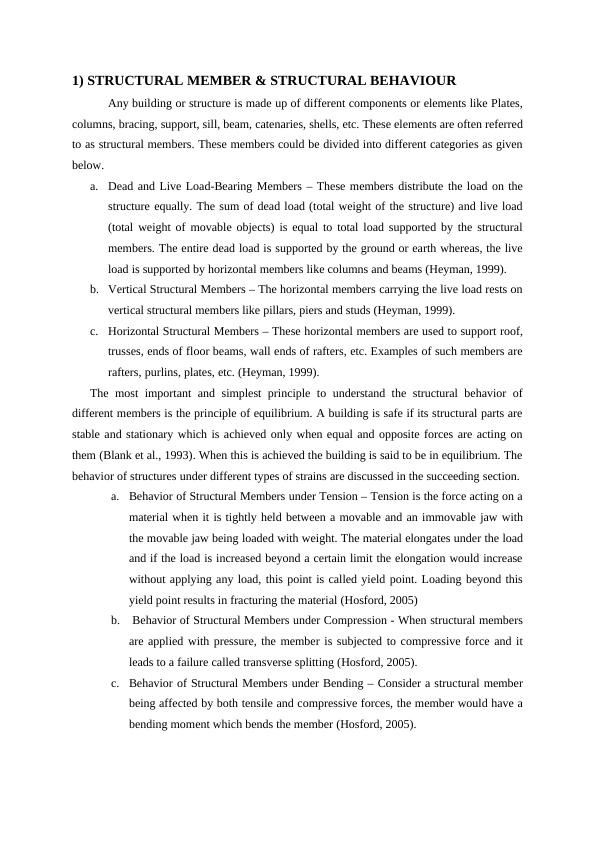
d.Behavior of Structural Members under Shear – If a structural member issubjected to an equal and opposite shear force on both sides, rotating forces areset up on the member. The rotating forces cause shear failure in structuralmembers (Heyman, 1999).e.Buckling – It is characterized by a sudden sideways deflection and occurs when astructural member is subjected tocompressivestress. The structural memberbecomes unstable and buckles when the load is increased and when the load isfurther increased the member loses its load carrying capacity (Heyman, 1999).2)BOND BEHAVIOUR & FLEXURAL BEHAVIOURThe bond amongst steel and cement is vital and fundamental so that they can acttogether with no slip in a stacked structure. With the ideal bond between them, the plane areaof a bar stays plane even in the wake of bowing. The length of a part required to build up thefull bond is known as the anchorage length. The strength of the bond is measured using itsBond Stress. The average bond stress is the average value of bond stress throughout theanchorage length and it changes with change in bending moment (Steuck, 2007).So, a proper anchor must be provided to the tensile member by adding length oneither sides of the point of maximum tension (Prince et al., 2014). This added length is calledDevelopment length in tension. For compression members this changes to Developmentlength in compression.It merits specifying that the twisted bars are known to be better than the smooth gentlesteel bars because of the nearness of ribs. In such a case, it is expected to check for theadequate development length just instead of checking both for the local bond stress anddevelopment length as required for the smooth gentle steel bars.The bond behaviour is characterised by the following test methods - pull-out tests(direct, bar, beam, flexural and double shear pull-out tests), beam end test, cyclic loading,monotonic loading, top bar effect, pull-out behaviour and beam end block bond test.Flexural strength is defined during a flexure test as the stress in a material just beforeit yields. If additional moment beyond the yield stress is applied on a structural member itwould not be able to support any more moment due to which inelastic deformation wouldoccur without the application of additional moment. These fully yielded members act likehinges.
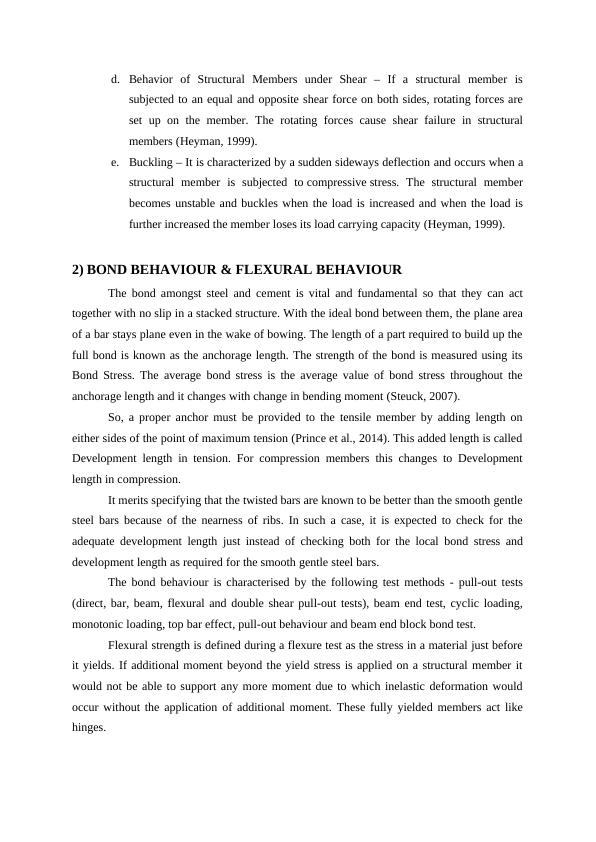
During bending of a member one side of the member is subjected to compression andthe other to tension, therefore the compression side is subjected to flexural buckling (Aydin,2009). But the member cannot buckle in the plane of loading as both the compression sideand tension side are connected to each other. So the buckling occurs in the lateral directionwhich is opposed by the tension side which rotates the member. Flexural compressive stresschanges with the length of the member and is predominant in compressive members like locallegs, flanges and plates.3)Bond Behavior and Flexural Behavior in Structural Level, MemberLevel and Material LevelThe transfer of stress between steel and concrete is governed by the bond reinforcingboth the materials. Bond at the member level and at the localized stress field is different.When one classification tends to the total impact of rebar pull-out causing an unreasonablerevolution at pillar section joints or breaks shaped in the straining zone. The otherclassification addresses the micro-structure which crushes the steel lug edge (Spacone et al,1996). The bond requires development length and if the bond deteriorates the reinforcingbars may most likely slip which would cause a failure in the steel-concrete composite action.This may lead to a brittle failure due to an impulse or an earthquake (Ngo et al., 2007).Spacing, rebar placement, anchorage and member width affect the bond strength and causescracking failure in concrete structures. Research demonstrated that the bond strength declinesas the bar width increments and that there is a notable effect on the bond due to increase inusual stress around the bar caused by confinement (Esfahani et al., 2007).Thus, a bond has various capacities including strength and ductility and is influencedby many variables like positioning, rebar spacing, packaging and concrete cover. Contingentupon the maker, certain bars have ribs at a point which impacts pull-out and bond behaviour.Demonstration indicate that the straight pull-out is reduces under static loading and increasesunder dynamic loading for similar designs (Usmani et al., 2001). Cyclic stacking causesrotation in the vicinity of strain and pressure at a similar part area and consequently requiresthe examination of inversion of part constraints registered from a static investigation.The performance in the member level drops due to the combined effects of localizedbond slip. Specifically, shaft section joints would experience extra pivot past the level caughtby direct flexible examination.At the point when the strengthening steel begins to move in
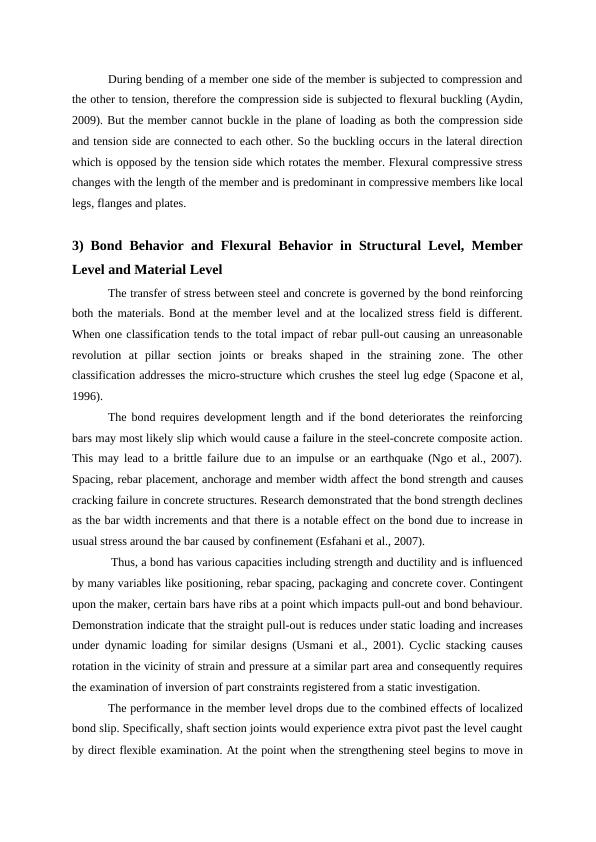
respect to concrete, the individuals associated with the joints experience extra turn in respectto each other (Bazant and Bhat, 1997). Domains in the area of shaft segments joints inmoment restricting frames subjected to dynamic loading are affected the most in light of thefact that the flexible conduct at the joints scatters the vitality conferred into the superstructureby seismic tremors (Filippou et al., 1983). Bond deterioration influences the overall structural behaviour when subjected todynamic loading. Hysteresis is caused by extra turn at the joints because of bond slip. In theflexible range the forced distortion bend is a straight line, however, when the joints turn at noextra moment the forced distortion bend turns into a level. Right when load reversal happens,the joint starts rotating the other way while attracting the bar in contact with the point that itbears against concrete. At that point, the bar on the backward side of the pole starts its pullingcycle. Structural behaviour is also affected by maturing of concrete. No institutionalizeddirect trial procedures are available to purposely age cement and test it on that premise.Hence, most solid lab for maturing would be the outside genuine circumstance in urbancommunities where reinforced concrete constitutes by far most of the structures. Placementquality and blend structural design are imperative and have an immediate association withbond deterioration and aging. Proportionally mixed concrete has a better life span thanconcrete that is not mixed proportionally. Essential structures that are proposed to withstanddynamic loading portrayed by code, will unmistakably perform better than anything than theones that are definitely not.4) Bond Behavior and Structural Behavior between Concrete and Steel BarReinforcementThe bonding at the concrete – steel interface is affected by the load exchange betweenconcrete and steel, which ensures that the strengthening withstands both pressure and strain.Bond strength increases with increase in concrete compression strength but reduces withincrease in the bar diameter (Shannag and Charif, 2017). All strengthened concrete structuresrely upon the bond between concrete and steel bar (Alkaysi and Tawil, 2017), a fundamentalauxiliary property of strengthened concrete and indicates that the bond between the steelsupport and concrete is accountable for the relocation of axial force between these twocomponents hence giving strain similarity and two fold activity of steel and concrete,furthermore, pullout tests give a clear technique and a straight forward way to compare bond

behavior (Prince and Singh, 2014). The bond in cement and steel is most crucial for the basicexecution and the safety of the framework relies on holding the fortified solid structureswhere the bond behavior is associated with relative rib locale of the bar (Bosco and Tondolo,2012). The bond framework is activated at the moment when a relative slip among steel andconcrete starts (FIB Bulletin no 10, 2000). The steel reinforcements are subjected tocorrosion which causes internal damage and leads to the failure of reinforced concretestructure (Ouglova et al., 2008). Another problem that affects the reinforcing steel frameworkis isolation, which reduces the bond between concrete and steel bars (Dakhil et al, 1975).After the attachment isolates, slip begins and the shear stresses cause friction (de Villiers etal, 2017). Steel reinforcement having lower maximum bond shear strength and higher bondcoefficients reduce the slip displacement and increase the kinetic energy absorption beforereaching the elastic limit (Hall and Najim, 2014). Bond stress cannot be exchanged to theplain bar support as they don't have any lugs or other surface contortions (Abrams, 1913).The compatibility between steel reinforcement and concrete is lost because of flexural splits(Mylrea, 1948). The strength of concrete depends on its resistance against physical and chemicalfactors (Fang et al, 2004). For smooth bars the slip at the bond crest is low. Reinforcementshaving large diameter have lower mechanical interlock (Maranan et al, 2015). Deformed barsare subjected to bond failure because of the radical cracks around the bars which splits theconcrete and due to the local crushing of concrete (Tepfers et al., 1973). When the traversereinforcement is high and the rib height is low local crushing will be large and this type ofbond failure is ductile and does not cause size-effect (Ichinose et al., 2004). But when the ribheight is large and the traverse reinforcement is low the concrete splits to produce a brittlefailure which causes size-effect (Ichinose et al., 2004).5) Flexural Behavior between Steel Bar Reinforcement and ConcreteFlexural conduct is normal for a slim basic component subjected to an outer loadconnected oppositely to a longitudinal pivot of the component. Flexural quality is themechanical parameter to characterize a material's capacity to oppose twisting under load.Flexural conduct of a basic part can be checked through a three-point flexural test where the
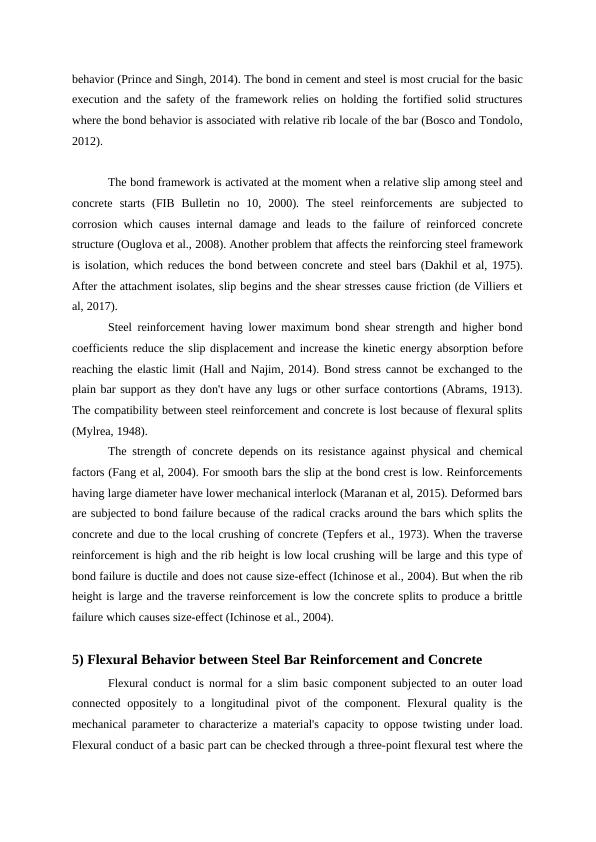
heap is connected to the component until the point when it curves and cracks (Zaki et al.,2011). The test gives brings about terms of flexural modulus of versatility, otherwise calledflexural quality (Teo et al., 2006). Aside from that, amid the three-point flexural test,diversion of the test component can likewise be resolved to screen how much the componentcan twist and avoid stress. It is important to decide the flexural quality as a component of theplan of solid blends to check consistency with built up details or to give data important to theoutline of a building structure (Teo et al., 2006).Flexural testing of the auxiliary Nano engineered fibre strengthened cementitiouscomposites utilized scored bar specimens and was directed by the standard BS EN14651 (BSEN 14651, 2005). It is realized that utilizing the score to control the area of the underlyingbreaking balances out the post-split conduct. Moreover, the durability ascertained from aload–crack mouth opening displacement curve is more exact than that acquired from a load–deflection curve.Concrete flexural member resists bending on the compression side, while no bendingstress is negligible on the tension side. Therefore, the capacity of flexural members iscalculated by avoiding the concrete part on the tension side (Djamaluddin, 2013). The largestbending stress in a loaded flexural beam consists of the tensile and compression bendingstresses which occur at the top and bottom fibres. Shear stress is evenly distributedthroughout the beam and tension bending stress is resisted by the steel reinforcement,whereas the compression bending stress is resisted by the concrete (Djamaluddin, 2013). Theability of reinforced concrete beam section to resist bending moment is the nominal bendingmoment capacity of the reinforced concrete beam. When this capacity is breached the beambends and the steel reinforcement acts like a cable so that it could be in line with the beamduring its deformation (Djamaluddin, 2013). The yielding of steel reinforcement followed bycompression failure near loading points causes failure of the concrete flexural member.6) Necessity of Steel Bar Reinforcement in ConcreteReinforced concrete performed viably as a composite material because the steelsupport is clung to the encompassing cement (Sofi et al., 2007). The bond between theencompassing concrete and the rebar guarantees that the rebar does not slip in respect to theconcrete and in this manner enables neighbourhood strengths to be exchanged over the steel-concrete interface. With no bond or other mechanical association, the steel is totally
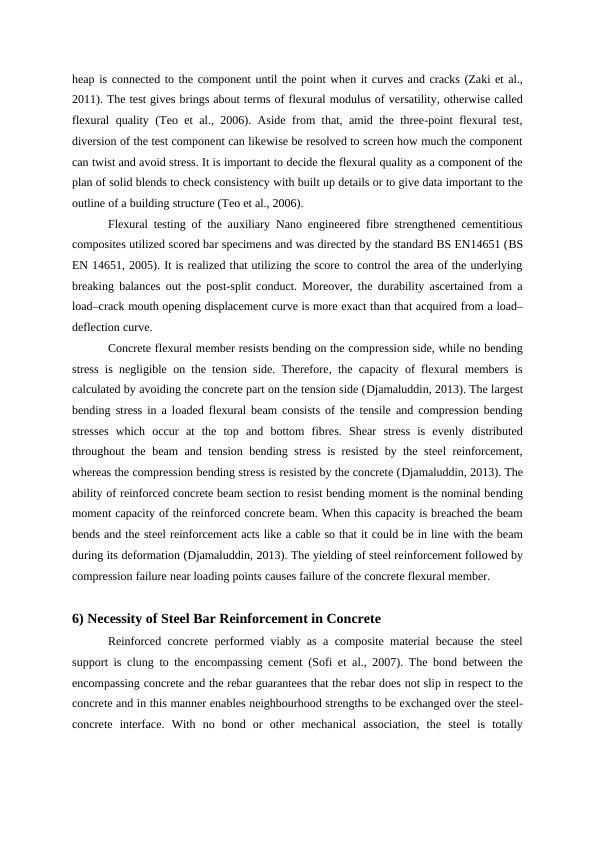
End of preview
Want to access all the pages? Upload your documents or become a member.
Related Documents
Bridge Design: Loads, Girder Design, Bearing Design, Bridge Economicslg...
|5
|939
|493
Understanding Beams: Behavior, Failure Modes, Stresses, and Types Used in Constructionlg...
|13
|2852
|300
Report on Space Structureslg...
|13
|3644
|179
